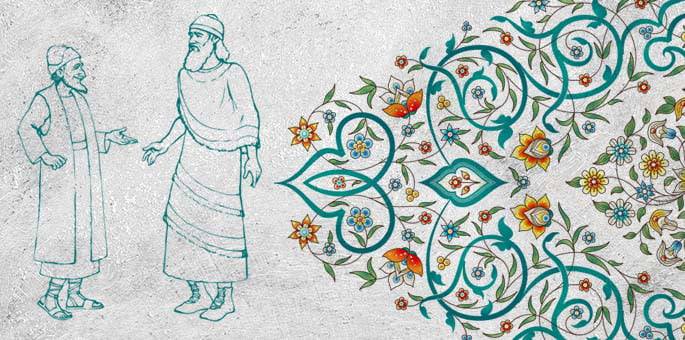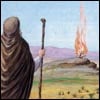The word “exilarch” (“head of the exile”) is a Greek loan translation of the Hebrew rosh galut and Aramaic reish galuta. This title was given to the political head of the (at times) semi-autonomous Jewish community in Babylon, who traced his lineage to King David.
Although we don’t find much record regarding the functions of the office of the exilarch until around the 2nd century, the origins of the exilarch can be traced to the period immediately preceding the destruction of the First Temple, some 600 years earlier.
Origins of the Exilarch: The Exile of Jeconiah
In the year 3327 (434 BCE),1 eleven years before the destruction of the First Holy Temple, King Jeconiah (also referred to as Jehoiachin or Coniah) succeeded his father, Jehoiakim, as king of Judah. He only ruled for three months (and ten days) before King Nebuchadnezzar of Babylonia laid siege to Jerusalem and King Jeconiah surrendered peacefully. Nebuchadnezzar plundered Jerusalem and the Temple and took many prominent Jews, including King Jeconiah and the prophet Ezekiel, to Babylon.
(Nebuchadnezzar had Zedekiah, uncle of King Jeconiah and third son of King Josiah, installed as king of Judea. Eventually, despite the protest of the prophets, Zedekiah rebelled against Nebuchadnezzar, who then returned to Jerusalem in the year 3336 [425 BCE] and again besieged the city on the 10th of Tevet. This culminated in the destruction of the Temple approximately two and a half years later, on the 9th of Av. While attempting to flee, Zedekiah and his sons were captured, and Zedekiah was forced to watch his sons be executed before he too was taken as a prisoner to Babylon.)
In the 37th year of Jeconiah’s captivity, Evil-Merodach ascended the throne and freed Jeconiah from prison.2 In the words of the concluding verses of the Book of Kings:
And it was in the 37th year of the exile of Jehoiachin, king of Judah . . . that Evil-Merodach, king of Babylonia, in the year of his coronation, lifted up the head of Jehoiachin, king of Judah, and released him from prison. And he spoke with him kindly and placed his throne above the throne of the kings who were with him in Babylon. And he changed his prison garb, and he ate meals before him regularly all the days of his life. And his meals, regular meals were given him from the king, each day's need in its day, all the days of his life.3
This act gave renewed hope to the exiled Jews that, eventually, the royal house of David would once again rise from the ashes. In fact, the Talmud and Midrash tell us that in His mercy, G‑d caused Jeconiah, together with thousands of Jews—including the Sanhedrin—to be exiled eleven years prior to the destruction of the Temple so that by the time the actual exile to Babylonia occurred, there would already be a somewhat established Jewish leadership there.4 Thus, the seeds for redemption were already planted before the destruction was complete.
(In a fascinating find during an excavation of ancient Babylon by the German archaeologist Robert Johann Koldewey that took place between the years 1899 and 1917, a royal archive room of King Nebuchadnezzar was found. Among the tablets are two that are now known as “Jehoiachin's rations tablets,” which describe the rations given by the Babylonians to Jeconiah and his five royal sons.)
The book of I Chronicles lists some of the descendants of King Jeconiah, including Zerubbabel, son of Shealtiel, son of Jeconiah,5 who ultimately went up to Jerusalem in the times of Ezra to build the Second Temple with the permission of the Persian King Cyrus. According to the Seder Olam Zuta, Shealtiel was considered the first exilarch.6
Not much is known about the various exilarchs who lived during the Second Temple era. However, Seder Olam Zuta, as well as other works like Iggeret Rav Sherira Gaon, list the names of the exilarchs, tracing them all the way back to King Jeconiah.
Office of the Exilarch
The exilarch had the authority to judge the Jews and appoint other judges, as well as supervise their operation. He oversaw the markets, customs and price regulations. He was also authorized to collect taxes and mete out penalties for violators of state law and those who disturbed the peace.
The position of exilarch came together with luxury and wealth, and thus the history of the exilarchs is a mixed bag, with lots of political upheaval. Although some were considered righteous Torah scholars, many others had considerably “less than stellar” reputations.
Most records regarding the exilarchs date from around the 2nd century until the end of the 10th century. However, traces of their descendants and people who went with the title (albeit without any power) can be found much later.7
Nasi vs. Reish Galuta
The Jews of Israel had a position similar to the exilarch, the nasi (“prince”), which was at times recognized by the Roman government. In fact, Rabbi Yehuda Hanasi, “Judah the Prince” (c. 135 CE–217 CE), the nasi in Israel, remarked that if the exilarch Mar Huna were to come to Israel, he would accord him great honor, but he would not relinquish the office of the nasi.8
Story of Bustenai
Perhaps one of the most famous exilarchs is Bustenai. There are many variations of the story, including with whom it took place.9 The basic story is as follows:
King Hormizd of Persia, who hated the Jews, decided to go about exterminating the royal house of David. No one was left of that house but an unborn child whose father had been killed. The king sought to kill the mother before the child would be born, effectively ending the Davidic line. Then the king dreamed that he was in a beautiful garden (bustan), where he uprooted the trees and broke the branches. As he was lifting up his ax against a little root, an old man snatched the ax away from him and gave him a blow that almost killed him, saying: "Are you not satisfied with having destroyed the beautiful trees of my garden, that you now try to destroy also the last root? Truly, you deserve that your memory perish from the earth." The king thereupon promised to guard the last plant of the garden carefully.
No one but an old Jewish sage was able to interpret the dream, and he said: "The garden represents the Davidic line, all of whose descendants you have destroyed except a woman with her unborn boy. The old man whom you saw was David, to whom you promised that you would take care that his house should be renewed by this boy." The Jewish sage, who was the father of the young woman, brought her to the king, and she was assigned to rooms fitted up with princely splendor. She gave birth to a boy, who received the name "Bustanai," from the garden that the king had seen in his dream.
Despite the prevalence of the story, others, most notably Rabbi Sherira Gaon (906–1006 CE), write that their families trace their roots back to the exilarchs before Bustonai, indicating that Bustonai was not the only surviving scion of the Davidic dynasty. Rabbi Sherira Gaon writes that on account of the deterioration of the exilarchate, his family renounced its claims to the office, preferring Torah scholarship and rabbinic leadership over palace intrigue.10
The End of the Exilarchate and Moshiach
In a fascinating exchange, the Talmud relates:11
Yehuda and Chizkiya, sons of Rabbi Chiya, were sitting at a meal before Rabbi Yehuda Hanasi, and they were not saying anything. Rabbi Yehuda Hanasi said to his servants: “Bring more wine for the young men, so that they will speak.” Once inebriated, they loosened their tongues and said: “The son of David [Moshiach] will not come until two patriarchal houses are destroyed from Israel. And they are the head of the exile in Babylonia and the nasi in Eretz Yisrael [referring to the family of their host!], as it is stated in reference to Moshiach: ‘And he shall be for a sanctuary; but for a stone of stumbling and for a rock of offense to both the houses of Israel.’12”
Now, why would these dynasties need to disappear in order for Moshiach to appear?
The commentaries explain that the Jewish people in general, and the house of David in particular, is compared to the lunar cycle, which waxes and wanes. In order for the moon to have a complete rebirth, it must first be completely hidden. It is only then that it can finally burst forth, reborn with new light. So, too, will Moshiach, a descendant from King David, burst forth with the new light of redemption.13 May it be speedily in our days!





Join the Discussion